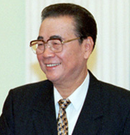- Chairman of the Standing Committee of the National People's Congress
-
Chairman of the Standing Committee of the National People's Congress of the People's Republic of China 
Emblem of the People's Republic of ChinaAppointer Vote within the Standing Committee of the National People's Congress Term length five years, renewable
once consecutivelyInaugural holder Liu Shaoqi Formation September 27, 1954 The Chairman of the Standing Committee of the National People's Congress (simplified Chinese: 全国人民代表大会常务委员会委员长; traditional Chinese: 全國人民代表大會常務委員會委員長; pinyin: Quánguó Rénmín Dàibiǎo Dàhuì Chángwù Wěiyuánhuì Wěiyuánzhǎng) is the chairman and/or speaker of the Standing Committee of the National People's Congress of the People's Republic of China, which is considered China's top legislative body. The current Chairman is Wu Bangguo.
The position has been ranked second in China's political hierarchy since Li Peng was barred from seeking a third term as Premier in 1998. In the political order of precedence, the Chair ranks below the CPC General Secretary and President, but above the Premier. The ranking of this position is according to the occupant's qualifications, however, is not necessarily reflective of its actual power, which varies depending on the officeholder.
Contents
Powers
The position holds reserve constitutional powers under the 1978 revision of the Constitution of the People's Republic of China. As stipulated in Article 84 of the Constitution, should both the President and Vice-President become incapacitated, and the National People's Congress is unable to elect a timely replacement, the Chairman of the NPC will act as President.[1]
Theoretically, during the Tiananmen Square Protests of 1989, the NPC Chair at the time, Wan Li, had the power to call an emergency session of the NPC to resolve the issue constitutionally. However, Wan's freedom of movement was restricted, and ultimately was powerless in the situation.
Chairmen of the NPC Standing Committee
de jure Head of State by the (1975 Constitution & 1978 Constitution)
Multiple terms in office, consecutive or otherwise, are listed and counted in the first column counts individuals and the second column (term number).
I# T# Chairman Took office Left office 1 1 Liu Shaoqi
刘少奇(劉少奇)

September 15, 1954 April 28, 1959 2 2 Zhu De
朱德

April 28, 1959 January 4, 1965 3 January 4, 1965 January 17, 1975 4 January 17, 1975 July 6, 1976 — Song Qingling
宋庆龄(宋慶齡)

July 6, 1976
(acting)March 5, 1978 3 5 Ye Jianying
叶剑英(葉劍英)

March 5, 1978 June 18, 1983 4 6 Peng Zhen
彭真June 18, 1983 April 13, 1988 5 7 Wan Li
万里(萬里)

April 13, 1988 March 27, 1993 6 8 Qiao Shi
乔石(喬石)

March 27, 1993 March 15, 1998 7 9 Li Peng
李鹏(李鵬)

March 15, 1998 March 15, 2003 8 10 Wu Bangguo
吴邦国(吳邦國)

March 15, 2003 March 15, 2008 11 March 15, 2008 Incumbent See also
- List of leaders of the People's Republic of China
References
Chairmen of the Standing Committee of the National People's Congress Liu Shaoqi · Zhu De · Soong Ching-ling · Ye Jianying · Peng Zhen · Wan Li · Qiao Shi · Li Peng · Wu Bangguo Italics denote acting Chairman
Italics denote acting ChairmanNational People's Congress 1st–9th (1954–2002) 
10th (2003–2007) 1st Plenary Session (2003) · 2nd Plenary Session (2004) · 3rd Plenary Session (2005) · 4th Plenary Session (2006) · 5th Plenary Session (2007)
11th (2008–2012) 1st Plenary Session (2008) · 2nd Plenary Session (2009) · 3rd Plenary Session (2010) · 4th Plenary Session (2011) · 5th Plenary Session (2012)
Standing Committee · ChairmanCategories:- Government of the People's Republic of China
- Law of the People's Republic of China
- Legislative speakers
- Standing committees
Wikimedia Foundation. 2010.


